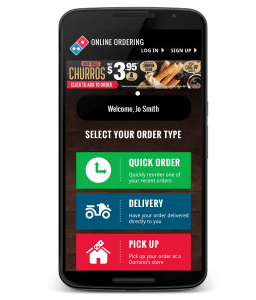
Imagine being presented with this idea by a Fortune 500 CEO in 2012: “Every company is a technology company.” Would you have felt it applied to your business? Six years on, it’s more true today than ever. Most companies utilize a cloud strategy to drive sales and deliver a better customer experience. For a tangible example, let’s look at something generally not associated with high tech: pizza. Since releasing their first pizza-tracking app in 2015, Domino’s Pizza stock price has rocketed from $114 to $243. In their most recent quarter, Domino’s crushed growth expectations by almost 2x. In addition to innovating by aligning their marketing and data intelligence strategies to ensure a great customer experience, when Domino’s created their own app, it began a new phase in their business.
So how does your company approach the idea that “every company is a technology company”. You might be thinking “we don’t sell pizza and our customers don’t buy on impulse.” Looking at it through another lens, a company’s ability to easily access its customer information and analyze its sales performance is a huge indicator of the friction any customer faces in the buying process. If data is siloed in brittle, tightly-coupled information systems, your customers will feel that friction in every transaction.
Even SMB and mid-market businesses seem to have many data islands, a lake of processes, and maybe a mountain of regulation. For an unregulated, mid-market business, there is tremendous opportunity to liberate your data from silos, get closer to your customer and run analytics on the results. By enabling key data in the cloud (Google Cloud Platform or Microsoft Azure, for example), you can gain the ability to quickly measure sales performance (and customer satisfaction) at a fraction of what it would have cost only a few years ago. So how do you quickly review your current IT state, then consider a cloud strategy that would improve your customer’s buying experience?
To look forward, let’s take a brief look back for context: in 1996, Microsoft released Exchange 4.0 which introduced a sea change in communications. IT integrators were busy telling the story of how email and the Internet would transform business productivity. Getting a decision maker to allocate budget for an email server, a file server, then a backup server, a print server (and on and on) was a challenging, interrupt driven odyssey. Into the early 2000s, as a network integrator, I saw businesses engage in consecutive IT projects to reactively “fix” issues or add a feature, rather than pursue a strategy driven technology plan.
Over the last few years, working with hundreds of businesses that have adopted a cloud approach to email and file sharing (and beyond), a consistent pattern has become evident. Many are now putting their key services into a flexible public cloud (think Google’s G Suite with Google Cloud Platform and Microsoft’s Office 365 + Azure). They are also building apps for internal use to simplify sales performance tracking and enable analytics around their most important data sets. Regardless of where a company is with its cloud strategy today, to look ahead, we must begin with the context of the business’ current technology stack.
So how do you start? To keep it simple, begin by visualizing the distinction between your company’s on-premise, virtualized and cloud-native workloads using the table below. Populate your key network services (email, file, authentication, HRIS, CRM, ERP, etc.) by era. This approach naturally identifies where your core services live (in legacy systems, virtualized systems or contemporary cloud). From this simple diagram, one can quickly do a gut check on how much of your IT services are likely current (agile, API enabled), legacy (brittle, siloed), or somewhere in between.

These general categories are important because they are indicators a company’s ability analyze business trends (sales, profitability, etc.). At this stage, the categories are more general than scientific – however, general rules of thumb apply: Non-virtualized servers tend to be siloed and tied to legacy systems. Virtualized servers generally offer greater flexibility in terms of management, migration and fail-over, however they could still represent significant data silos. Where you have siloed data, assume that the data is difficult to share, report on and access. These systems are likely creating unnecessary friction in your sales process, slowing down transactions and subjecting your customers to a negative digital experience. “Negative digital experience?” you might ask. Yes. (More on that in a bit.)

The next step should be include identifying your business goals, such as growth v. consolidation, acquisition v. divestiture, faster sales process, better customer experience, and the like. Also use this time to brainstorm about the business intelligence you’ll need to stay competitive while making it easier for your customers to buy.
The cloud strategy conversation should include executive leadership, IT, sales leaders, accounting, customer success, and an executive sponsor. You need to hear from those who determine the direction of the company, those who understand current IT barriers, and those interface with customers daily, among others. You also need to engage cloud experts who have worked with hundreds of businesses. Learn about what others are doing, and how. Ask about third alternatives and learn about data strategies that will help you innovate more quickly. In 2012, Stephen Denning, author of Age of the Agile: How smart companies are transforming the way work gets done (2018), wrote in Forbes, ‘the reality is that most firms today, whether they know it or not, are already software companies and will steadily become more so. Their competence in dealing with software will be a key part of their competitive edges — or lack thereof.“
If your key data is in the cloud, you can spin it like a diamond to view it from any angle. As a result, the reports you are able to create will help you understand your successes and quickly measure the impact of a pivot. Using the cloud, you can build a sales process around your customers and how they want to buy. Maybe that involves SaaS, custom built software, a web-based process, or an app. One thing is certain, those who can develop internal tools are adopting the cloud faster and in greater numbers.
Though the Fortune 500 executive may have seemed far off from your business in 2012, it’s fair to say that in 2018 every company is a technology company. Your customers associate your brand with a digital experience. The question is, who is managing that digital experience? Is that experience enabling you to win more business?
If you haven’t refreshed your cloud strategy in the last 6 months, print the diagram above, plot out your IT services by era, and do a gut check. Is your IT stack enabling collaboration, creativity and sales growth, or are your key business systems anchored in legacy silos? Think about getting the reports you’d really like to see about your business performance. Then engage a cloud expert to discuss a strategy that enables you to harvest the business intelligence that it’s already holding. Your Domino’s Effect may not be that far away.
Contact us to start your cloud transformation journey.

Jack Lamb
Sr. Account Manager
SADA Systems



